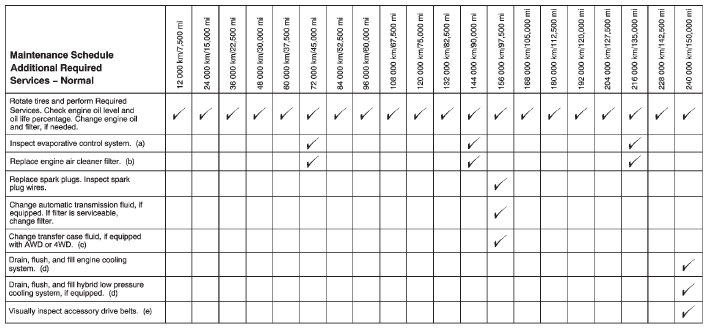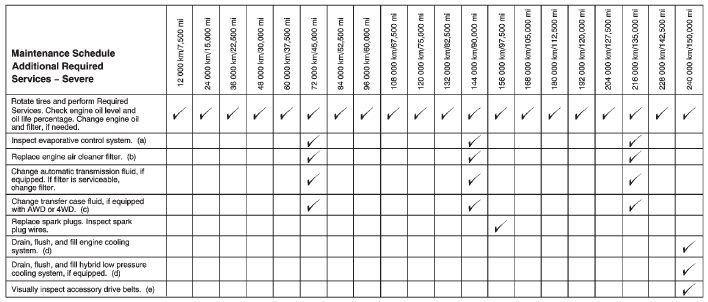Tire Rotation and Required Services Every 12 000 km/ 7,500 mi
Rotate the tires, if recommended for the vehicle, and perform the following services. See Tire Rotation .
- Check engine oil level and oil life percentage. If needed, change engine oil and filter, and reset oil life system. See Engine Oil and Engine Oil Life System .
- Check engine coolant level. See Engine Coolant .
- Check windshield washer fluid level. See Washer Fluid .
- Visually inspect windshield wiper blades for wear, cracking, or contamination. See Exterior Care . Replace worn or damaged wiper blades. See Wiper Blade Replacement .
- Check tire inflation pressures. See Tire Pressure .
- Inspect tire wear. See Tire Inspection .
- Visually check for fluid leaks.
- Inspect engine air cleaner filter. See Engine Air Cleaner/Filter .
- Inspect brake system.
- Visually inspect steering, suspension, and chassis components for damaged, loose, or missing parts or signs of wear. See Exterior Care .
- Check restraint system components. See Safety System Check .
- Visually inspect fuel system for damage or leaks.
- Visually inspect exhaust system and nearby heat shields for loose or damaged parts.
- Lubricate body components. See Exterior Care .
- Check starter switch. See Starter Switch Check .
- Check automatic transmission shift lock control function. See Automatic Transmission Shift Lock Control Function Check .
- Check ignition transmission lock. See Ignition Transmission Lock Check .
- Check parking brake and automatic transmission park mechanism. See Park Brake and P (Park) Mechanism Check .
- Check accelerator pedal for damage, high effort, or binding. Replace if needed.
- Visually inspect gas strut for signs of wear, cracks, or other damage. Check the hold open ability of the strut. See your dealer if service is required.
- Check tire sealant expiration date, if equipped. See Tire Sealant and Compressor Kit .
- Inspect sunroof track and seal, if equipped. See Sunroof .
- Check hybrid low pressure coolant level, if equipped.

Footnotes Ч Maintenance Schedule Additional Required Services Ч Normal
a) Check all fuel and vapor lines and hoses for proper hook-up, routing, and condition. Check that the purge valve, if the vehicle has one, works properly. Replace as needed.
b) Or every four years, whichever comes first.
c) Do not directly power wash the transfer case output seals. High pressure water can overcome the seals and contaminate the transfer case fluid. Contaminated fluid will decrease the life of the transfer case and should be replaced.
d) Or every five years, whichever comes first. See Cooling System .
e) Or every 10 years, whichever comes first. Inspect for fraying, excessive cracking, or damage; replace, if needed.

Footnotes Ч Maintenance Schedule Additional Required Services Ч Severe
a) Check all fuel and vapor lines and hoses for proper hook-up, routing, and condition. Check that the purge valve, if the vehicle has one, works properly. Replace as needed.
b) Or every four years, whichever comes first.
c) Do not directly power wash the transfer case output seals. High pressure water can overcome the seals and contaminate the transfer case fluid. Contaminated fluid will decrease the life of the transfer case and should be replaced.
d) Or every five years, whichever comes first. See Cooling System .
e) Or every 10 years, whichever comes first. Inspect for fraying, excessive cracking, or damage; replace, if needed.
See also:
Styling
The first-generation CTS set Cadillac on its current styling direction with
its creased, angular shape, but the design philosophy really hit its stride with
this second-generation car. Sharp edges ...
Recalling Button Memory Positions
To recall the manually saved Button Memory positions, press and hold У1Ф or
У2.Ф The driver seat, outside mirrors, and adjustable pedals, if available,
move to the positions stored to those buttons ...
Securing a Child Restraint Designed for the LATCH System
WARNING
If a LATCH-type child restraint is not attached to anchors, the child restraint
will not be able to protect the child correctly. In a crash, the child could be
seriously injured or k ...






